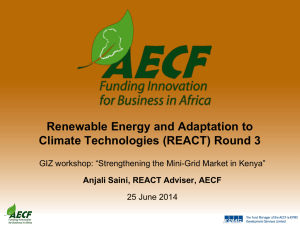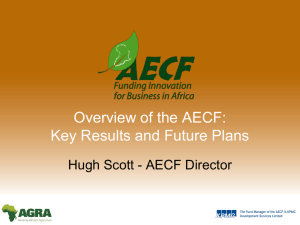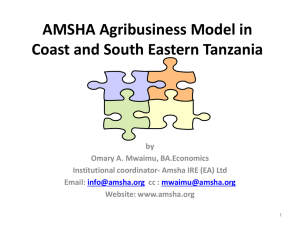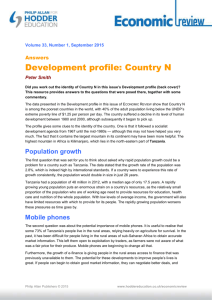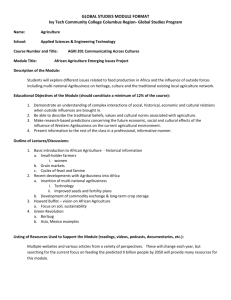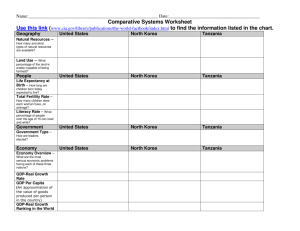Tanzania Agribusiness Window (TZAW): Round 4
advertisement
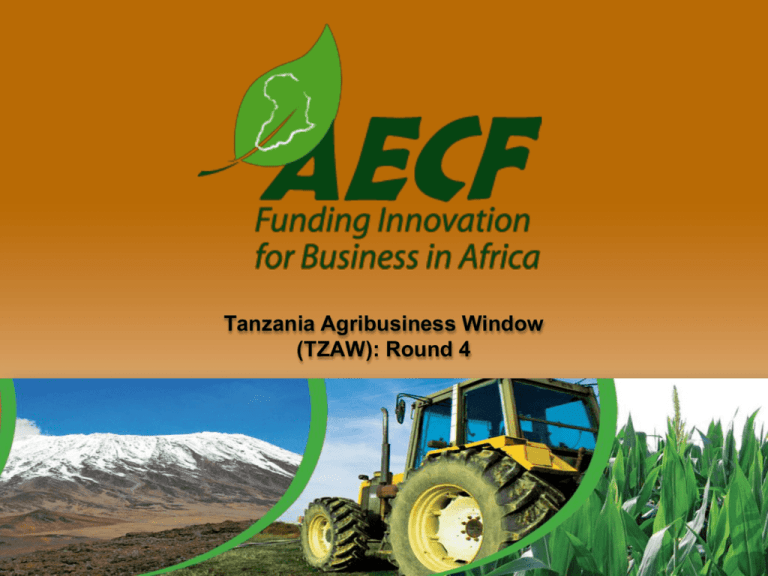
Tanzania Agribusiness Window (TZAW): Round 4 The Presentation Introduction to the AECF Goal/Purpose of the AECF Funders and Partners Finding the right projects TZAW R1-R3 Tanzania Agribusiness Window Round 4 Introduction Selection Criteria Competition Process Contact Information What is the AECF? The AECF is a fund of donor money available to the private sector on a competitive basis It is a special partnership initiative of the Alliance for a Green Revolution in Africa (AGRA) Funded by a multi-donor consortium (Dutch, DFID, DANIDA, SIDA, IFAD, CGAP). The donors form the Governing Council of the AECF Managed by a KPMG led team (the Fund Manager). Triple Line services provides M&E support. Initial capital was US$36m; now over US$245m 3 Aims & Objectives Goal: accelerate pro-poor growth in Africa – increasing employment, livelihood opportunities and income thereby reducing poverty. Purpose: to make agribusiness, finance, renewable energy and information market systems work better for the poor in rural areas in Africa Result: by improving the way market systems work, we aim to have a positive impact (jobs and incomes) on large numbers of people living in rural areas. Modus Operandi: The AECF works by supporting private sector companies to develop and test new and innovative business ideas 4 AECF is a special initiative of Funded by The members of donor consortium of the AECF include: How the AECF works The Model: The Focus : Agribusiness, rural financial services, renewable energy, adaptation to climate change, information and media services “Bespoke” competitions open to the private sector with eligibility and evaluation criteria to allocate funds to “best bids” AECF The Offer: The Reward: US$100,000 to US$1M, available to great business ideas (grants and/or repayable grants) Financial support for innovative business ideas (using matching fund principles) Starting Races rather than Picking Winners We seek projects that are commercially motivated & innovative to get systemic impact SCALE Commercial Motivation: Scale required for systems impact; scale will only be reached if business model is (very) profitable Disruptive Innovation: as a key indicator of systemic change potential • Upsetting the market such that others will copy and replicate – the more innovative the better Principle: Start races rather than picking winners VIABILITY (SOCIAL) IMPACT What is Tanzania Agribusiness Window (TZAW)? A special funding window for business ideas in agribusiness and information or financial services that will be implemented in Tanzania Goal: Contribute to wealth creation and rural poverty reduction in Tanzania Objective: To catalyse private sector investment and innovation in agribusiness and rural financial services projects that are commercially viable, have significant developmental returns and wider systemic impact. 8 What types of ideas are eligible? “Agribusiness” under the broadest possible definition – Farmers, planters, horticulturalists, livestock keepers & outgrower scheme operators – Inputs manufacturers, distributors & suppliers – Traders, merchants – Agro-processors and value adders Information services projects related to agriculture Financial services projects related to agriculture 9 TZAW To Date Three rounds of the competition completed with 37 businesses selected for funding US$ 22.9 million in grants and interest free loans committed US$ 57.3 million committed by awarded businesses as matching funds Funded by DFID and the Swedish Embassy Over 60,000 households reached in 2014 10 TZAW R1-3 Competitions Awarded grants Business plans Shortlisted for IC Concept notes submitted Registered companies 37 74 154 789 2,852 11 Agribusiness Projects in Tanzania Export Trading Ngongoseke Chobo Kilimo Markets Mara Kagera Tea Meru Agro Mount Meru Millers Kagera Arusha MSK Nsagali Quality Food Products Mwanza SmartMoney Africado Shinyanga Misenani Equity for Tanzania Serengeti Fresh Dorfra Trading SeedCo MeatKing Kigoma Tanga Verbruggen Dodoma Singida Ruaha Farms Rukwa Uncle Milo Iringa Lima Limited = TZAW R1 Projects (10) Mruazi Heifer Manyara Tabora = GW/AAW Projects (5) Beth Equisolutions Olivado EPZ Mtanga Farms Mbeya Rungwe Avocado Co Rift Valley Tea Sibesonke Ltd Agriseed Tanfeeds Greenbelt Mgolole AKM Glitters Darsh Morogoro Tanga Fresh Out-Growers Ltd Pwani Soko Fresh Sao Hill Kokoa Kamili DSM Corridor Group Kilombero Plantations = TZAW R2 Projects (10) Lindi = TZAW R3 Projects (17) Ruvuma 12 TZAW R4! Applications due by 15 December!!! The competition is funded by the UK Department for International Development (DFID) – approx. $5.4m funds available (approx. 10 companies) Companies may be from Tanzania or domiciled outside of Tanzania, but all projects must take place in Tanzania 13 Application Process Online application The competition launches at Stage 1 14 Eligibility Criteria Applicants must be for profit company, partnership or sole trader Project must be implemented in Tanzania Applications must be for new and innovative business ideas Request range from US$100,000 to US$1m and companies must match the funding requested in cash & kind (cash is preferable) Project must have significant development impact in rural areas Applicants must demonstrate that they would not go ahead without AECF funding or, if they would, that it would me at a much reduced pace or scale 15 Selection Criteria for Stage 1 Criterion Weighting Capacity of company 20% Strength of business case 25% Development impact 35% Innovation 20% 16 How much can I apply for? Applications can be for a mixture of grants and repayable loans Minimum amount US$100,000 maximum amount US$1m Remember: You must at least match the amount requested We are also looking for leverage – scores a better mark 17 How do I apply? Go to www.aecfafrica.org and register using your email address Download the guidance notes – essential for completing application form Fill out the application in Microsoft Word – you must submit in Word. Extra information (attachments, etc) will not be read Submit the application to tzaw@aecfafrica.org by 15 December 2015 18 Sections of Application Brief Summary Section A: Applicant Company Information Section B: Project Information Section C: Proposed Business Idea Section D: Innovation Section E: Additionality Section F: Project Impacts Section G: Risks & Assumptions 19 Brief Summary Complete at the end Concisely summarize key points of idea and expected impact and outcomes 20 Section A: Applicant Company Information Provide basic data about your company – Note: all contact will go to the person and contact information listed on this form Registration details, current business, past financial performance, financing 21 Section B: Project Information Basic project details (title, location, etc.) Funding information – both AECF and matching – AECF funding is US$ 100,000 – US$ 1,000,000 – Matching funds must be equal to or greater than the amount requested from AECF 22 Section C: Proposed Business Idea Concise description of idea Concise business case – include numbers! Explain your market and your strategy for reaching it i.e., distribution, logistics, sales, etc. Capacity of the team – be specific but do not paste CVs List and justify how AECF funding will be used 23 Section D: Innovation AECF defines “innovation” as a new product, service or business model being introduced in a country or to a target group where it has not been tried before Make sure to substantiate your claims of innovation 24 Section E: Additionality TZAW R4 will not consider projects which could and would be funded fully by other, more commercial, sources of funding Answer the listed questions specifically This section is not about why AECF should be interested in your project and should not repeat what you have said in other sections about the innovation, impact, etc. 25 Section F: Project Impacts AECF monitors a set of standard quantitative and qualitative Key Performance Indicators (KPIs) for all TZAW projects Provide figures on what you have achieved so far (i.e. the baseline numbers) and estimates of what your project is expected to achieve by the end of the 6 year AECF project period Numbers should address only AECF project 26 Section F: Project Impacts – Financial Indicators Turnover EBITDA 27 Section F: Project Impacts – Development Indicators Number of Households Reached – Direct beneficiaries – either your customers or suppliers; not employees! Net Benefit per Household – Calculation of cost benefit or cost savings compared to situation if project did not go ahead Number of Household with Reduced Risk to Extreme Weather Events – Only if appropriate to your business; do not try to fit something into this if it does not make sense 28 Section F: Project Impacts – Employment Indicators Total number of people employed (full-time) Total number of people employed (part-time) as full-time equivalents Percentage for women Percentage for under 35 Wage bill 29 Section F: Project Impacts – Wider Impact Impact on other businesses Impact on laws, policies, regulations Physical infrastructure Sources of information Reduction in other adverse business factors Replication of your idea Will anyone be “crowded out”? 30 Section F: Environmental Impact Indicate whether or not an EIA is required If required: explain the progress to date and plans for completion If not: explain why not and include information on any clearances from the government that can confirm this 31 Section G: Risks & Assumptions Business Environmental Health & Safety Social 32 CONTACT DETAILS +254 20 269 9137/8/9 www.aecfafrica.org tzaw@aecfafrica.org www.facebook.com/AecfAfrica www.twitter.com/AecfAfrica
